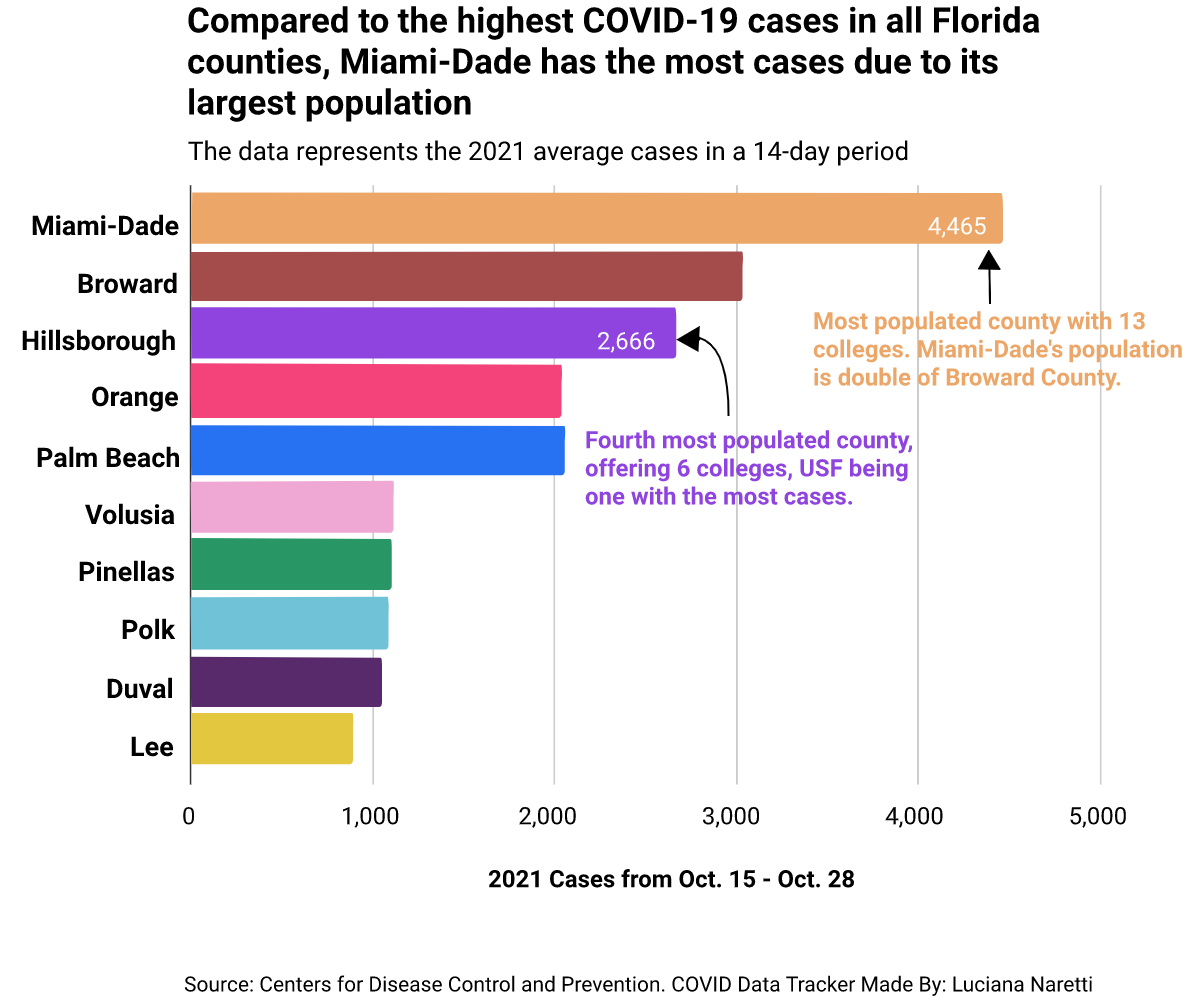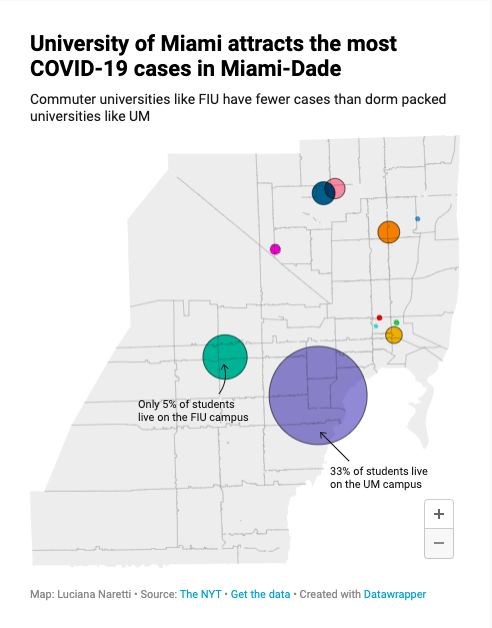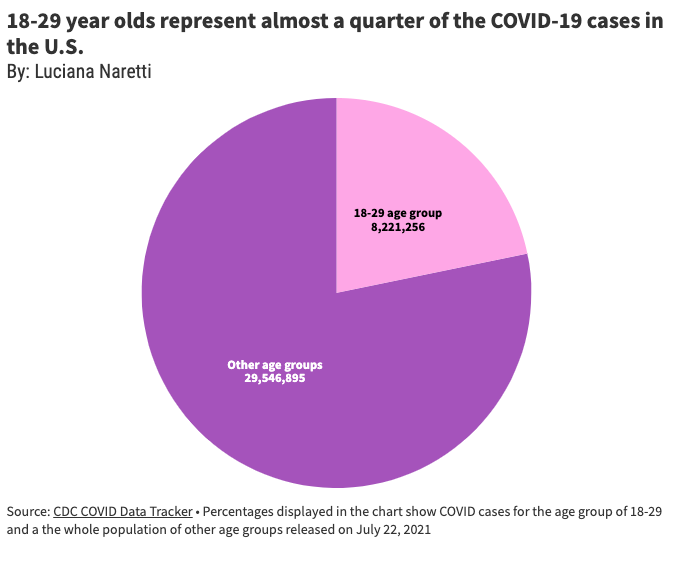When universities opened in fall 2021, many faculty members, staff, and students were concerned. Many universities encouraged vaccinations but did not demand them. Although states enforced rules such as social distancing and mask mandates, it was unclear whether breakout cases would occur after the full reopening of classes.
Many universities are situated in highly clustered counties. Therefore, in these places, there are more COVID cases in data records. Consider Florida, the nation’s third-largest state.

Miami-Dade County is ranked as the highest in cases because of its high-density population. The data collected from the CDC showed Miami-Dade having 4,465 cases in a 14-day period in 2021: October 15 to 28. Broward, which ranks second in the state, had around 3,000 cases.
Miami-Dade is a cultural melting pot of mostly Hispanic communities. Many of these communities are home to commuter universities. Floridas International University is one of them.
Located in the city of Miami, FIU is in one of the largest populated and COVID-packed counties. A large portion of the FIU population is from the community, lives in their parent’s homes or in apartments off-campus. The higher the surrounding community’s population, the higher the number of cases at the university.
Mary Jo Trepka, epidemiology researcher and FIU professor, noticed the differences between universities like Florida International University and the University of Florida.
“There is more of a cluster of people going back to UF once school starts that are not from the community,” she said.
The University of Florida is in Gainesville, which is situated in a comparatively less populated county: Alachua. The county did not even reach the top 10 most COVID-infested counties. But many people travel to UF from all over the nation. On the other side, FIU is in a bigger county where people permanently stay and drive to campus.
UF likely had a higher number of cases because it is a large university situated in a community where many people travel and stay on campus for short periods of time.
Fabiana Verastegui, 21, a junior studying veterinary at FIU, does not feel uncomfortable being on campus and worries people do not care about the virus.
“I still get a bit paranoid that people are not taking this seriously because I feel like, at this point, you should wear at least a mask out of respect to the other students,” she said.
She said that although a large number of the population wears masks, most people on campus refuse to wear coverings outside and inside classrooms.
All universities revealed their 2020 COVID cases, but most did not upload the current cases of 2021. https://www.datawrapper.de/_/dbkFz/
https://www.datawrapper.de/_/dbkFz/
The University of Miami, a private school, located in Miami-Dade, has more than double the cases that FIU has. UM’s current 2020–21 school year population is 17,809, while FIU has 58,836. UM houses 33% of its students on campus, while FIU only houses 5%.
Several universities have campuses closely linked to hospitals or medical facilities that assist doctors. UM has three hospitals, which increases the risk of contamination among students and faculty members. UM is one of the only health centers in South Florida that offer students to work in hospital facilities.
Sebastian Morales, 20, a senior student at U.M., said most students always wear their masks in classes and even in noncrowded spaces.
“I think plenty of students makes a decent effort to stay safe, but most students are very careless,” he said.
He is not surprised UM has more cases than FIU does.
“I can see UM having more cases in part due to at least my perceived idea that there is a core, close-knit community and higher density,” he said. “UM has a significant number of students in their dorms, and that itself would logically lead to higher transmission rates.”
Sports such as football brought back stadium-packed games with thrills of feeling normal once again, while homecoming in October brought live music for students on campus to enjoy.
Epidemiologist and USFG professor Edwin Michael researched whether events or sports occurring throughout the fall of 2020 affected university COVID rates.
“We did this analysis last Fall and found that games with fans did not lead to significant outbreaks in the wide community post games,” he said. “We found that the main reason for any difference between county outbreaks surrounding these football games was whether face mask mandates were in place or not.”
He said the rate exposure of these big events like Homecoming will affect how vaccination rates stand.
“Some breakthrough infections may occur, but this would be small. Also, since students will have got their vaccines later than older groups, their immunity from vaccination would still be high enough to contain/prevent infection from any exposure.”

The third visualization shows the 18–29-year-old age group. They typically represent a large percentage of college students. Despite the controversies around the U.S. depicting universities as hotspots for COVID-19, younger adults are more likely to get vaccinated, said Michael.
Many factors contribute to universities having high COVID-19 cases. However, with vaccinations and mask enforcement, the future may seem bright for incoming freshmen that want to experience the typical college lifestyle.

































